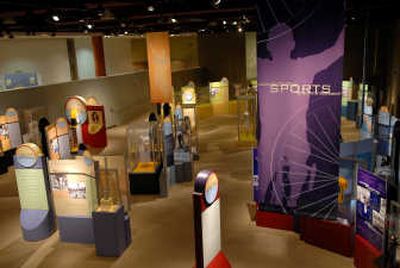Sports exhibit honors innovators

Sports make for unbeatable scrapbooks. And that’s the essence of “Sports: Breaking Records, Breaking Barriers,” a Smithsonian-developed exhibit now at the Northwest Museum of Arts and Culture.
Thirty-three individuals, from the greatest athletes of all time to unsung innovators – and the 1980 “Miracle on Ice” United States hockey team – are featured in the display, making its 10th and final stop in a three-year national tour. The exhibit’s stay at the MAC runs through Jan. 1.
This is a high-minded enterprise, to be sure – focusing on social significance of sports, perhaps at the expense of some of the fun.
“The greatest champions stand for more than the records they break,” writes the curator, Ellen Roney Hughes, in her introduction. “They stand for the barriers they shatter – physical, social, psychological, cultural – and change the way we think about our world.”
That’s undeniable, and a single glimpse of Jackie Robinson in the team photo of the 1947 Brooklyn Dodgers is enough to prove it. From Billie Jean King to Roberto Clemente to Jim Thorpe to, of course, Muhammad Ali, the Smithsonian has rounded up the heaviest of sports’ cultural icons and put their artifacts under glass – the singlet Roger Bannister wore when he outraced John Landy in Vancouver and the goggles Gertrude Ederle fashioned to swim the English Channel.
To say nothing of the handball Abraham Lincoln used to let off steam in some back alley during the Presidential campaign of 1860.
Some of the choices are curious. Terry Bradshaw won four Super Bowls, but did he really “change the way we think about our world?” Was skateboarder Tim Brauch truly “more than a sports champion?”
But then, what are sports if not an argument starter?
An important part of the exhibit is given over to “Barrier Removers” – specifically, inventors like James Plimpton (the rocker roller skate) and Marilyn Hamilton (the tennis wheelchair) who opened up new vistas for recreation. The inventor of tailgating, alas, remains unknown.
Sports scream for a more multimedia approach to its history than what the Smithsonian has put together here – although there is a short video as part of the display, and Web site links are available. But the medium in this case is less important than the message, as summed up by the exhibit’s national spokesman, basketball great Bill Russell:
“Sports inspire us,” Russell offers, “both individually and as a nation to be better.”